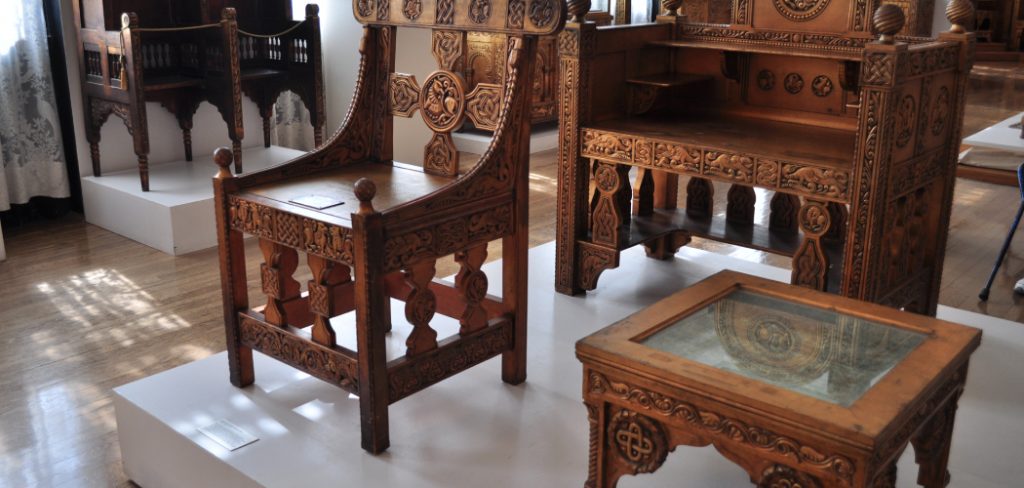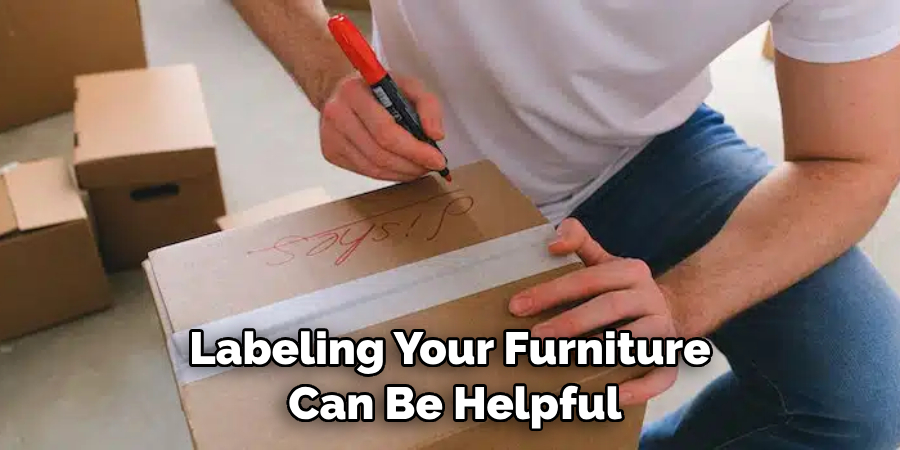Do you need to store wood furniture for an extended period of time and want to make sure it remains in great condition? You can protect your pieces from the elements with proper wrapping techniques.

In this blog on how to wrap wood furniture for storage, we’ll discuss tips for how to wrap wood furniture such as recliners, chairs, tables and more so they remain safe during storage periods. Read on to learn how you can safely store away your favorite furnishings!
Needed Materials
Given below are the materials you need to wrap wood furniture for storage.
- Plastic Sheeting
- Bubble Wrap
- Packing Tape
- Furniture Cover (Optional)
- Labels or Markers (Optional)
11 Step-by-step Guidelines on How to Wrap Wood Furniture for Storage
Step 1: Clean and Prep the Furniture
Before you start wrapping the furniture, it is important to make sure that it is free from dirt and dust. Use a damp cloth to wipe down the furniture and ensure that all surfaces are clean. It is also a good idea to repair any broken knobs, handles, and legs before wrapping the furniture. This will help prevent any further damage. But most importantly, it will make unpacking and reassembling the furniture easier.
Step 2: Remove Hard Objects
If your furniture contains any removable hard objects such as knobs, handles, or drawers, take them off and store them in a safe place. This will help prevent damage during storage. It is also important to double check that all drawers are empty before wrapping them.

If is also a good idea to take photos of the furniture before you start wrapping it so that reassembling will be easier. This will also help you keep track of any missing pieces.
Step 3: Cover with Plastic Sheeting
Take the plastic sheeting and cut it into large pieces for wrapping around the furniture’s surface area. The sheeting should be large enough to reach several inches past each side of your furniture piece. Secure the sheeting with packing tape around each edge so that it stays in place.
Make sure there are no gaps or openings in the plastic sheeting to prevent dust and moisture from entering. It is also important to note that while this step is necessary, it will not provide adequate protection from the elements.
Step 4: Secure with Bubble Wrap
Once you have secured the furniture with plastic sheeting, it is time to wrap it with bubble wrap. Cut the bubble wrap into large pieces that vary slightly in size so that no area of the furniture is too densely wrapped. Start by wrapping each side of the furniture separately before moving to the top and bottom.
Secure all edges of the bubble wrap with packing tape, making sure there are no open gaps for dust or moisture to enter through. It is important to note that the bubble wrap should be snug but not too tight as it can cause damage to the furniture.
Step 5: Add a Furniture Cover (Optional)
If you want extra protection for your furniture, consider adding a furniture cover overtop of your already wrapped furniture. The cover should be snug and secure, with no openings or gaps for dust to enter. It is also important to make sure that the cover does not rub against any of the edges as this can cause damage and scratches. But keep in mind that furniture covers are not necessary and can be skipped if desired.

Step 6: Label the Furniture (Optional)
If you are storing your furniture in a separate location from where it was originally kept, consider labeling it with a marker or label maker as an added precaution. This will help you easily identify which piece of furniture is which when unpacking at a later date.
If you are using a label maker, make sure to apply the label on a part of the furniture that is not covered in bubble wrap or plastic sheeting. It is important to note that labeling is completely optional and can be skipped if desired.
Step 7: Securely Pack the Wrapped Furniture
Once you have secured all sides of the furniture, it’s time to pack it away for storage. If using corrugated cardboard boxes, make sure that they are large enough to fit all sides of the wrapped item without squeezing too tightly around it. If you are using a storage container, make sure to place the furniture in the center of the box and secure it with packing tape should gaps or openings form during transportation.
Step 8: Place Furniture on Pallets (Optional)
If you are storing your furniture for an extended period of time, consider placing it on pallets before wrapping it. This will help lift your furniture off the ground slightly and reduce any potential moisture damage that may occur while in storage. But keep in mind that this step is optional and can be skipped if desired. If you do choose to use pallets, make sure to secure them with packing tape before wrapping the furniture.
Step 9: Arrange Furniture in Boxes
Organizing your wrapped pieces of furniture into boxes helps keep them organized and easy to find when unpacking at a later date. It is important not to overfill each box with too much weight as this can cause the sides to buckle. This can also be prevented by using special moving boxes which are designed to handle heavier weights.

Step 10: Place Boxes in the Storage
When all boxes of furniture are securely packed and organized, place them in their designated storage area. Make sure that the area is secure and free from any water or pest damage. Avoid storing your furniture near windows or other sources of direct sunlight as this may cause fading or discoloration over time. It is also important to check the temperature of the storage area and ensure that it does not exceed 70 degrees Fahrenheit.
Step 11: Check on Furniture Periodically
Depending on how long you plan to store your furniture, it is important to check on it periodically. This will help ensure that all pieces remain dry and free from dust or other damage while in storage for an extended period of time.
Always make sure to open the boxes and inspect the furniture for moisture or dust buildup. If you notice any issues, consider rearranging the furniture in different boxes or storing it in a different area.
Now that you know how to wrap wood furniture for storage, you can have peace of mind that your favorite furnishings will stay safe during a long-term storage period. Be sure to follow these 11 steps for the best results and longest-lasting protection. Thanks for reading and happy storing!
Do You Need to Use Professionals?
For some items, you may need professional help to wrap wood furniture for storage. If your pieces are too large or heavy to move on your own, consider hiring a professional moving company or furniture wrapping service. They will be able to properly pack and secure your furniture so that it remains safe during transport and storage.
Professional services can also come in handy if you have valuable antiques or heirloom pieces that require extra care when packing away for storage. Professional movers and wrappers are trained and experienced in taking the necessary steps to ensure these types of items remain safe while in transit or storage.
Frequently Asked Questions
Q: How Can I Protect My Furniture From Moisture Damage While in Storage?
A: In addition to wrapping your furniture with plastic sheeting and bubble wrap, it is also important to place them on pallets before moving into storage. This will help lift the furniture off the ground slightly and reduce any potential moisture damage that may occur while in storage.
Q: Do I Need To Label My Furniture Before Storing It?
A: Labeling your furniture can be helpful if you are storing it away from its original location. Use a marker or label maker to easily identify which piece of furniture is which when unpacking at a later date.

Q: How Much Packing Tape Should I Use?
A: Make sure to use enough packing tape to securely fasten all edges of the plastic sheeting and bubble wrap around your furniture’s surface area for maximum protection. Additionally, use packing tape to securely fasten any furniture covers in place and seal any potential gaps or openings in the containers that you are using for storage.
Q: How Often Should I Check On My Furniture While in Storage?
A: Depending on how long you plan to store your furniture, it is important to check on it periodically. This will help ensure that all pieces remain dry and free from dust or other damage while in storage for an extended period of time. Make sure to check on your items at least once every few months or more often if needed.
Conclusion
Wrapping wood furniture for storage is a great way to protect it from the wear and tear of time. Not only does it safeguard against scratches, dust, dirt, and moisture but also adds an extra layer of security against breakage or other damage.
While this type of protection takes some effort up front, the peace of mind that can come with knowing our furnishings will remain safe for years to come is well worth the work.
Now that you know how to wrap furniture for storage successfully, you can tackle other organizational tasks like cleaning your closets or organizing deep bathroom drawers. Stay organized and take action – you are sure to see amazing results! Thanks for reading this article on how to wrap wood furniture for storage.

